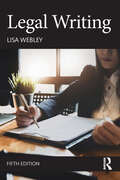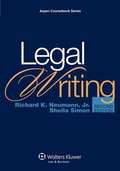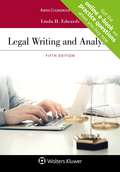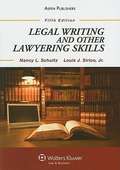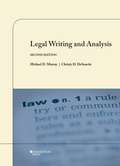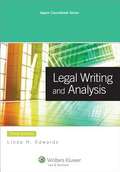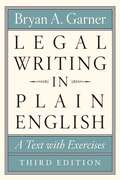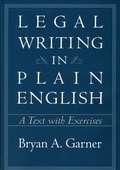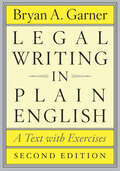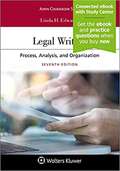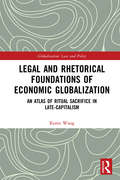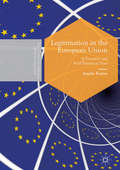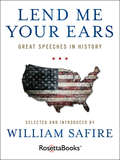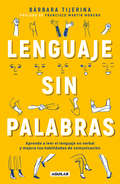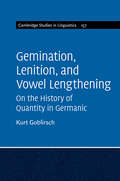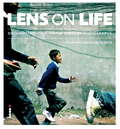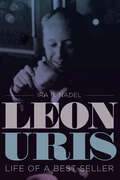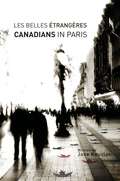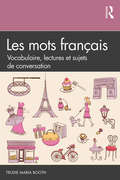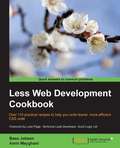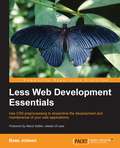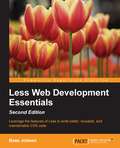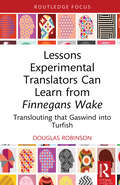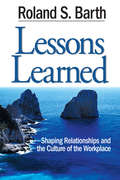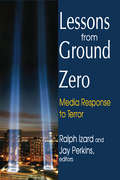- Table View
- List View
Legal Writing
by Lisa WebleyLegal Writing guides students comprehensively through this vital legal skill and addresses a range of assessment methods from exam questions to final essays and problem answers. It considers how to deconstruct essay and problem questions and how to conduct and apply legal research to answer set questions. Lisa Webley explains how to reference others’ work clearly and correctly, making this book a useful tool for students concerned about issues of plagiarism. Legal Writing also focuses on how to develop critical thinking and communicate legal arguments, with both good and bad examples of written work considered and discussed in the text. Legal Writing is particularly useful for undergraduate students, especially at the beginning of degree studies, as well as for those preparing for the SQE exams. This fully revised fifth edition includes: Guidance on how to avoid plagiarism, including examples of the best and worst practices Worked examples throughout the text, including how to decipher essay questions in exams and coursework An expanded set of accompanying digital learning resources with increased guidance for revision to allow students to test their progress and further engage with the topics in the book. Clearly written and easy to use, Legal Writing enables students to fully engage with essay and exam writing as a vital foundation to their undergraduate degree.
Legal Writing (2nd Edition)
by Sheila J. Simon Richard K. Neumann Jr.Written for law students, this well-organized and thorough book shows how to hone legal writing skills in real-world situations. Topics include process, style, memoranda writing, organizing analysis (CREAC), analytical writing, persuasive writing, telling a client's story, making the client's argument, appellate briefs, and oral argument. Each chapter includes exercises. Appendices contain sample memos and briefs. An accompanying access code protected website offers supplementary material including videos, checklists, and articles. Annotation ©2011 Book News, Inc. , Portland, OR (booknews. com)
Legal Writing And Analysis (Aspen Coursebook)
by Linda Holdeman EdwardsThis streamlined text offers a straightforward guide to developing legal writing and analysis skills for beginning legal writers. Legal Writing and Analysis, Fifth Edition by Linda Edwards, leads students logically through reading and analyzing the law, writing the discussion of a legal question, and writing office memos, letters, and briefs. The text includes chapters on citation form, writing style, professionalism, and oral argument. <P><P> The book features special focus on forms of legal reasoning (rules, analogies, policies, principles, customs, inferences, and narrative) complete with examples and exercises. It teaches students to recognize rule structures and use them to organize their document. <P><P> New to the Fifth Edition: Streamlined chapters and exercises Updated citation materials covering current editions of both citation manuals Product page featuring more material on professional letters and accessible coverage and use of legal theory <P><P>Professors and students will benefit from: Contextual learning, including important legal method material Superior treatment of how to organize a legal discussion Clear, ample coverage of legal reasoning Practice-oriented approach Numerous examples and short exercises for formative assessment Strong coverage of professional responsibility
Legal Writing And Other Lawyering Skills, 5e
by Nancy L. Schultz Louis J. Sirico Jr.With a consistent emphasis on precision and good organization, Legal Writing and Other Lawyering Skills, Fifth Edition, shows students how tod raft memoranda, opinion letters, pleadings, briefs, and other legal documents. But because communication in the practice of law occurs in specificcontexts, authors Nancy L. Schultz and Louis J. Sirico, Jr . teach other valuable lawyering skills, such as client counseling, negotiating,and how to present an oral argument before the court, in this timely andstudent-friendly text. Now with a more contemporary look that reflects a new publisher and revisions requested by users of the text, the Fifth Edition of Legal Writing and Other Lawyering Skills features: a straightforward and student-friendly approach, framed and supported by a logical organization, streamlined coverage that focuses on basic communication skills in practice, complete coverage of legal writing--with outstanding chapters on writing style and how to write a memo, in-depth instruction on legal analysis, oral argument, and how to write an appellate brief, a helpful preliminary overview of the American legal system, refreshed, updated, and carefully honed practice exercises, expanded coverage of electronic research, new coverage of electronic communication, format, etiquette, ethics, and liability, thoroughly up-to-date court citations, cases, and sample documents, generous use of sample documents within the text and in the Appendices. The focused exercises and examples in Legal Writing and Other Lawyering Skills, Fifth Edition, simulate the tasks performed by lawyers in practice and reflect the authors' forward-looking, practice-based approach to teaching writing and lawyering skills to law students.
Legal Writing and Analysis (Coursebook Ser.)
by Michael Murray Christy DeSanctisThis law school text teaches the fundamentals of legal writing, analysis, and the American legal method. It fosters critical lawyering skills, such as how to identify a legal rule from a variety of sources, analyze and explain its components, apply the rule to answer a problem, and communicate the results in an effective manner. In the second edition, coverage of authority and rule formation have been streamlined and tightened. The authors have increased the visual appeal and content of callout boxes, charts, and tables; and they have replaced and shortened the length of examples so as to provide two to three times as many samples of practitioner writing in each chapter. With this new edition, the authors endeavor to train future lawyers to be ethical and professional issue-spotters, analysts, counselors, problem-solvers, and communicators working to advance their clients’ interests.
Legal Writing and Analysis (Third Edition)
by Linda H. EdwardsIdeal for beginning legal writers, this logically organized and exceptionally well-written text offers a concise and straightforward guide to legal writing and analysis. Updated to include exercises with increased focus on first-year courses, Legal Writing and Analysis, Second Edition, starts with an overview of the legal system and the lawyer¿s role, then leads students from reading and analyzing the law through the process of legal writing, providing numerous examples and exercises along the way. Classroom-tested features of this bestselling text include: a consistent use of the legal method approach, from an opening chapter providing an overview of a civil case and the lawyer¿s role, to information about the legal system, case briefing, synthesizing cases, and statutory interpretation an emphasis on analogical reasoning and synthesizing cases, as well as rule-based and policy-based reasoning, with explanations of how to use these types of reasoning to organize a legal discussion a logical organization that starts with reading and analyzing the law and then moves on to writing the discussion of a legal question, writing an office memo and professional letters, and advocacy writing. chapters addressing style and formality considerations as well as oral advocacy effective coverage of the use of precedent a superior discussion of small-scale organization, including the thesis paragraph numerous examples and frequent short exercises that encourage students to apply concepts a comprehensive Teacher¿s Manual that offers helpful advice for instructors. The Second Edition offers new exercises, including increased focus on first-year courses. a revision of Part Five on advocacy writing, streamlining the order of the chapters and adding more coverage of questions presented an updated citation chapter. Chapter 12 on the Office Memorandum has been expanded to add another format for a question presented and is accompanied by an example
Legal Writing in Plain English, Third Edition: A Text with Exercises (Chicago Guides to Writing, Editing, and Publishing)
by Bryan A. GarnerThe leading guide to clear writing—and clear thinking—in the legal profession for more than two decades, now newly updated. Admirably clear, concise, down-to-earth, and powerful—all too often, legal writing embodies none of these qualities. Its reputation for obscurity and needless legalese is widespread. Since 2001, Bryan A. Garner’s Legal Writing in Plain English has helped address this problem by providing lawyers, judges, paralegals, law students, and legal scholars with sound advice and practical tools for improving their written work. Now the leading guide to clear writing in the field, this indispensable volume encourages legal writers to challenge conventions and offers valuable insights into the writing process: how to organize ideas, create and refine prose, and improve editing skills. Accessible and witty, Legal Writing in Plain English draws on real-life writing samples that Garner has gathered through decades of teaching experience. Trenchant advice covers all types of legal materials, from analytical and persuasive writing to legal drafting, and the book’s principles are reinforced by sets of basic, intermediate, and advanced exercises in each section. For this third edition, Garner has retained the structure of the previous versions, with updates and new material throughout. There are new sections on making your writing vivid and concrete and on using graphics to enhance your argument. The coverage and examples of key topics such as achieving parallelism, avoiding legalese, writing effective openers and summaries, and weaving quotations into your text have also been expanded. And the sample legal documents and exercises have been updated, while newly added checklists provide quick summaries of each section. Altogether, this new edition will be the most useful yet for legal professionals and students seeking to improve their prose.
Legal Writing in Plain English: A Text with Exercises
by Bryan A. GarnerAdmirably clear, concise, down-to-earth, and powerful-- unfortunately, these adjectives rarely describe legal writing, whether in the form of briefs, opinions, contracts, or statutes. In Legal Writing in Plain English, Bryan A. Garner provides lawyers, judges, paralegals, law students, and legal scholars sound advice and practical tools for improving their written work. The book encourages legal writers to challenge conventions and offers valuable insights into the writing process: how to organize ideas, create and refine prose, and improve editing skills. In essence, it teaches straight thinking-- a skill inseparable from good writing. Replete with common sense and wit, the book draws on real-life writing samples that Garner has gathered through more than a decade of teaching in the field. Trenchant advice covers all types of legal materials, from analytical and persuasive writing to legal drafting. Meanwhile, Garner explores important aspects of document design. Basic, intermediate, and advanced exercises in each section reinforce the book's principles. (An answer key to basic exercises is included in the book; answers to intermediate and advanced exercises are provided in a separate Instructor's Manual, free of charge to instructors.) Appendixes include a comprehensive punctuation guide with advice and examples, and four model documents. Today more than ever before, legal professionals cannot afford to ignore the trend toward clear language shorn of jargon. Clients demand it, and courts reward it. Despite the age-old tradition of poor writing in law, Legal Writing in Plain English shows how legal writers can unshackle themselves. Legal Writing in Plain English includes: *Tips on generating thoughts, organizing them, and creating outlines. *Sound advice on expressing your ideas clearly and powerfully. *Dozens of real-life writing examples to illustrate writing problems and solutions. *Exercises to reinforce principles of good writing (also available on the Internet). *Helpful guidance on page layout. *A punctuation guide that shows the correct uses of every punctuation mark. *Model legal documents that demonstrate the power of plain English.
Legal Writing in Plain English: A Text with Exercises (Chicago Guides to Writing, Editing, and Publishing)
by Bryan A. Garner“This easy-to-follow guide is useful both as a general course of instruction and as a targeted aid in solving particular legal writing problems.” —Harvard Law ReviewClear, concise, down-to-earth, and powerful—all too often, legal writing embodies none of these qualities. Its reputation for obscurity and needless legalese is widespread. For more than twenty years, Bryan A. Garner’s Legal Writing in Plain English has helped address this problem by providing lawyers, judges, paralegals, law students, and legal scholars with sound advice and practical tools for improving their written work. The leading guide to clear writing in the field, this indispensable volume encourages legal writers to challenge conventions and offers valuable insights into the writing process that will appeal to other professionals: how to organize ideas, create and refine prose, and improve editing skills.Accessible and witty, Legal Writing in Plain English draws on real-life writing samples that Garner has gathered through decades of teaching. Trenchant advice covers all types of legal materials, from analytical and persuasive writing to legal drafting, and the book’s principles are reinforced by sets of basic, intermediate, and advanced exercises in each section.In this new edition, Garner preserves the successful structure of the original while adjusting the content to make it even more classroom-friendly. He includes case examples from the past decade and addresses the widespread use of legal documents in electronic formats. His book remains the standard guide for producing the jargon-free language that clients demand and courts reward.“Those who are willing to approach the book systematically and to complete the exercises will see dramatic improvements in their writing.” —Law Library Journal
Legal Writing: Process, Analysis, And Organization (Aspen Coursebook)
by Linda H. EdwardsBuy a new version of this textbook and receive access to the Connected eBook with Study Center on CasebookConnect, including: lifetime access to the online ebook with highlight, annotation, and search capabilities; practice questions from your favorite study aids; an outline tool and other helpful resources. Connected eBooks provide what you need most to be successful in your law school classes. Learn more about Connected eBooks Legal Writing: Process, Analysis, and Organization, Seventh Edition by the 2017 Burton Award recipient and renowned author, Linda Edwards, is the only legal writing text that uses a process approach, presenting writing as a logical sequence of steps. Streamlined to meet the needs of today’s students, the Seventh Edition uses adult learning theory concepts and a “flipped classroom” approach to add even greater focus and efficiency to classroom and study time. Key Features: New Chapter (4) on working with statutes. Updated chapter on citation Improved coverage of brief-writing Streamlined chapter on letter writing to better meet the need of a first-year course. Modern process approach, with streamlined content for better absorption by students Clear and informal language Helpful appendices offering sample of office memos, sample letters, and appellate briefs.
Legal and Rhetorical Foundations of Economic Globalization: An Atlas of Ritual Sacrifice in Late-Capitalism (Globalization: Law and Policy)
by Keren WangThis book examines the subtle ways in which rhetorics of sacrifice have been re-appropriated into the workings of the global political economy in the 21st century. It presents an in-depth analysis of the ways in which ritual practices are deployed, under a diverse set of political and legal contexts, as legitimation devices in rendering exploitative structures of the prevailing political-economic system to appear inescapable, or even palatable. To this end, this work explores the deeper rhetorical and legal basis of late-capitalist governmentality by critically interrogating its mythical and ritual dimensions. The analysis gives due consideration to the contemporary incarnations of ritual sacrifice in the transnational neoliberal discourse: from those exploitative yet inescapable contractual obligations, to calendrical multi-billion dollar 'offerings' to the insatiable needs of 'too-big-to-fail' corporations.The first part of the book provides a working interpretative framework for understanding the politics of ritual sacrifice – one that not only accommodates multidisciplinary, interdisciplinary knowledge of ritual practices, but that can also be employed in the integrated analysis of sacrificial rituals as political rhetoric under divergent historical and societal contexts. The second conducts a series of case studies that cut across the wide variability of ritual public takings in late-capitalism. The book concludes by highlighting several key common doctrines of public ritual sacrifice which have been broadly observed in its case studies. These common doctrines tend to reflect the rhetorical and legal foundations for public takings under hegemonic market-driven governance. They define 'appropriate and proper' occasions for suspending pre-existing legal protections to regularize otherwise transgressive transfers of rights and possessions for the 'greater good' of the economic order.
Legitimation in the European Union: A Discourse- and Field-Theoretical View (Postdisciplinary Studies in Discourse)
by Amelie KutterThis book offers a transdisciplinary perspective on the question of how political legitimacy is constructed in the increasingly contested postnational setting of the European Union. Drawing on the example of the controversy about the EU constitution and the use of ‘EU constitution speak’ in commentaries published by Polish and French broadsheets, it reveals the transformation that constructions of political authority and association undergo when they are being transposed from the discourse field of multilateral negotiation to that of national news media. Through an original combination of the linguistic theory of discourse developed in Critical Discourse Analysis, Bourdieu’s field theory and notion of symbolic power, and political thought on polity-building, it develops a framework for the discourse study of legitimation and Europeanisation, and proposes applications beyond the case studies in the book.To students of European integration, it demonstrates the potential these concepts have for unravelling the implicit practices of postnational polity building. Discourse researchers, on the other hand, will discover how detailed text analyses gain significance in debates related to the macro level of political organisation when guided by sociological and political theory.
Lend Me Your Ears: Great Speeches in History
by William SafireFrom a Pulitzer Prize–winning author, this collection of speeches is &“the most valuable kind of book, the kind that benefits mind and heart&” (Peggy Noonan). This third edition of the bestselling collection of classic and modern oratory offers numerous examples of the greatest speeches ever delivered—from the ancient world to the modern. Speeches in Lend Me Your Ears span a broad stretch of history, from Gen. George Patton inspiring Allied troops on the eve of D-Day to Pericles&’s impassioned eulogy for fallen Greek soldiers during the Peloponnesian War; and from Jesus of Nazareth&’s greatest sermons to Ruth Bader Ginsburg&’s fiery speech in response to the Bush vs. Gore decision that changed the landscape of American politics in our time. Editor William Safire has collected a diverse range of speeches from both ancient and modern times, from people of many different backgrounds and political affiliations, and from people on both sides of history&’s greatest battles and events. This book provides a wealth of valuable examples of great oratory for writers, speakers, and history aficionados.
Lenguaje sin palabras: Aprende a leer el lenguaje no verbal y mejora tus habilidades de comunicación
by Bárbara TijerinaEl lenguaje no verbal es determinante para el éxito o el fracaso en tu vida, en tu trabajo y en tus relaciones. Comunicar no sólo es dar información, sino también transmitir, conmover, persuadir, emocionar y hacer sentir a través de los gestos, la postura y la voz. Tu comunicación no verbal representa el 93% del impacto que causarás en los otros. ¿Cuántas veces te ha pasado que alguna persona te dice "sí", pero sospechas que realmente dijo "no"? El lenguaje sin palabras es el único canal de comunicación en el que es imposible mentir, en el que la gente expresa su yo verdadero, incluso sin darse cuenta; es una herramienta social que ayuda a entender al otro y a conectar mejor con los demás. Este libro te enseñará a leer las emociones y a interpretar el lenguaje no verbal de todos los que te rodean para que descifres qué es lo que están transmitiendo de manera inconsciente y cómo se sienten en determinadas situaciones: -Detectarás seguridad o inseguridad en las personas. -Diferenciarás si muestran arrogancia o frustración o si están a la defensiva. -Sabrás si alguien está nervioso, ansioso o preocupado. -Reconocerás si la persona está interesada o muestra indiferencia. Estas herramientas te permitirán tener congruencia entre lo que dices, lo que haces y lo que eres, y te ayudarán a mejorar la comunicación con los que te rodean y a elegir la manera ideal para transmitir tu mensaje. Si sabes reconocer, identificar y mover las emociones de alguien más, será muy fácil venderle, persuadirlo y hasta hacerlo votar por ti.
Lenition and Vowel Lengthening in the Germanic Languages: On the History of Quantity in Germanic (Cambridge Studies in Linguistics #157)
by Kurt GoblirschThe processes of gemination, lenition, and vowel lengthening are central to the study of phonology, as they reveal much about the treatment of quantity in a given language.<P><P> Using data from older language stages, modern dialects and standard languages, this study examines the interdependence of vowel and consonant quantity in the history of the Germanic branch of Indo-European. <P>Kurt Goblirsch focusses on the various geminations in Old Germanic languages (West Germanic gemination, glide strengthening, and expressive gemination), open syllable lengthening in German, Dutch, Frisian, English, and Scandinavian languages, and the major lenitions in High German, Low German, and Danish, as well as minor lenitions in Bavarian, Franconian, and Frisian dialects. All of these changes are related to the development of the Germanic languages from distinctive segmental length to complementary length to syllable cut. The discussion challenges traditional theoretical assumptions about quantity change in Germanic languages to argue for a new account whereby, gemination, lenition, and vowel lengthening are interrelated.<P> Uses extensive linguistic data, including examples from historical texts, modern dialects, and the standard Germanic languages.<P> Accessible to linguists in fields other than Germanic, providing chapter summaries and English glosses of all examples for non-specialists.<P> Highly comparative, and presents a broader Germanic picture for English, German and Scandinavian specialists.
Lens on Life: Documenting Your World Through Photography
by Stephanie C. RobertsMostly candid and spontaneous, documentary photography serves to preserve a moment in time. In Lens on Life, celebrated documentary photographer Stephanie Calabrese Roberts inspires you to explore, shoot, and share documentary photographs, guiding you as you define your own style. Illustrated with the author's striking artwork as well as that of eight seasoned photographers who have visually documented stories all over the world, this book will sharpen your artistic intuition and give you the confidence to take on personal or professional documentary assignments. Full of advice that will challenge you and strengthen your photography, Lens on Life shows you how to capture an authentic view of your world.
Leon Uris: Life of a Best Seller (Jewish History, Life, and Culture)
by Ira B. NadelThe first biography of the massively popular author of Exodus and Trinity, who &“was as feisty as any of his fictional creations&” (Publishers Weekly). As the #1 New York Times–bestselling author of Exodus, Mila 18, QB VII, and Trinity, Leon Uris blazed a path to celebrity with books that readers couldn&’t put down. Uris&’s thirteen novels sold millions of copies, appeared in fifty languages, and were adapted into equally successful movies and TV miniseries. Few writers equaled his fame in the mid-twentieth century. His success fueled the rise of mass-market paperbacks, movie tie-ins, and author tours. Beloved by the public, Uris was, not surprisingly, dismissed by literary critics. Until now, his own life—as full of drama as his fiction—has never been the subject of a book. Now Ira Nadel traces Uris from his disruptive youth to his life-changing experiences as a marine in World War II. These experiences, coupled with Uris&’s embrace of his Judaism and desire to write, led to his unprecedented success and the lavish excesses of a career as a best-selling author. Nadel reveals that Uris lived the adventures he described, including his war experiences in the Pacific (Battle Cry), life-threatening travels in Israel (Exodus), visit to Communist Poland (Mila 18), libel trial in Britain (QB VII), and dangerous sojourn in fractious Northern Ireland and the Irish Republic (Trinity). Nadel also demonstrates that Uris&’s talent for writing action-packed yet thoroughly researched novels meshed perfectly with the public&’s desire to revisit and understand the tumultuous events of recent history—making him far more popular (and wealthier) than more literary authors—while paving the way for future blockbuster writers such as Irving Wallace and Tom Clancy.
Les Belles Etrangeres: Canadians in Paris (Perspectives on Translation)
by Jane KoustasWhile translation history in Canada is well documented, the history of the translation of Canadian fiction outside the nation remains obscure. Les Belles Étrangères examines the translation of Canadian English-language fiction in France. This book considers the history of this practice, the reasons for the move away from Quebec translators as well as the process and perils involved in this detour. Within a theoretical framework and drawing on primary sources, this study considers the historical, theoretical, and concrete aspects of this practice through the study of the translations of authors such as Robertson Davies, Carol Shields, Margaret Atwood, Michael Ondaatje, Ann-Marie MacDonald, and Alistair MacLeod. The book also includes a comprehensive bibliography of English-language novels, poetry, and plays published and translated in France over the past 240 years. Published in English.
Les mots français: Vocabulaire, lectures et sujets de conversation
by Trudie Maria BoothLes mots français: Vocabulaire, lectures et sujets de conversation presents a clear, thorough and systematic overview of modern French vocabulary on a variety of subjects. Written in the target language, each of the 32 chapters is divided into the following sections, with translations into English to facilitate the learning process: • basic vocabulary (vocabulaire de base) • additional vocabulary (vocabulaire supplémentaire) • related vocabulary (vocabulaire apparenté) • idiomatic expressions, sayings and proverbs (proverbes et expressions) • cultural readings (lectures). The book includes a range of communicative exercises and sample sentences, while an answer key and flashcards are available online. This is essential reading for learners at level A2–C2 of the Common European Framework for Languages, and Intermediate Mid–Advanced on the ACTFL proficiency scales.
Less Web Development Cookbook
by Bass Jobsen Amin MeyghaniAimed at those who want to overcome the limitations of CSS, through this book you will begin to harness the efficiency of Less by building advanced, responsive, and modern websites. Experienced web developers, students, and even web designers will find this guide very useful as they enhance their CSS skills.
Less Web Development Essentials
by Bass JobsenWritten in a practical and concise manner, this book is a crash-course in teaching you the fundamental concepts of Less with real-life examples and problems. If you use CSS(3) in your web development tasks and would love to learn how to create maintainable and reusable code with Less, this book is ideal for you. Although you need to have some experience in web development, even beginners will find that this book is useful.
Less Web Development Essentials - Second Edition
by Bass JobsenIf you use CSS for web development tasks and want to learn how to create maintainable and reusable code, this is the book for you. Basic knowledge of web development would be helpful.
Lessons Experimental Translators Can Learn from Finnegans Wake: Translouting that Gaswind into Turfish (Routledge Advances in Translation and Interpreting Studies)
by Douglas RobinsonInspiring translators by making specific experimental writing strategies available to them, this book reimagines experimental translation through close readings of Finnegans Wake.Robinson’s engagement with translational aspects of Finnegans Wake provides rich and useful insights into experimental translation that encourage new approaches to translation theory and practice. The author analyses Joyce’s serial homophonic translations, portmanteau words, and heteronyms along translational lines (following Fritz Senn, Clive Hart, Patrick O’Neill, and others), and offers a showcase translation of Walter Benjamin’s “Task of the Translator” using all three experimental techniques borrowed from the Wake.The book will be a valuable addition to any postgraduate course in translation theory, literary theory, and Joycean literature. Translation scholars, students, and researchers will find this text a compelling read.
Lessons Learned: Shaping Relationships and the Culture of the Workplace
by Roland S. BarthBarth shares his often whimsical, but always thoughtful reflections on relationships at sea and in the workplace.
Lessons from Ground Zero: Media Response to Terror
by Jay PerkinsIt ranked among journalism's finest hours. That is what was heard in the weeks following September 11, 2001. They made mistakes, of course, but in covering one of the biggest disasters ever to hit the United States, journalists used their training, their experience, their understanding, and their sensitivity to provide coverage that helped bring understanding and a sense of calm to the chaos. Their performance did not end with reporting the immediate impact of the catastrophe. They continued to analyze what happened, the impact to property and human lives, the impact on government and foreign relations. Lessons from Ground Zero's examines journalism's efforts to cover a crisis, while analyzing journalism itself. Many lessons were evident to journalists as they sought to cope with the challenges of covering 9/11. The long-term question, however, is whether the answers they found served as catalysts for better journalism in the future, or whether they have been forgotten, put into the closet of old memories with no noticeable long-term impact. This book analyzes journalists' response to 9/11 through scholarly research and interviews with many of the journalists who covered 9/11. Sometimes they do not agree, but all are thoughtful and each adds to understanding. Public opinion polls show clearly that citizens appreciated and responded to media coverage. Given that this occurred in a time frame in which public approval of American journalism had declined, it is reasonable to ask what the media did that was different from their normal practices. This book provides some of the answers.
